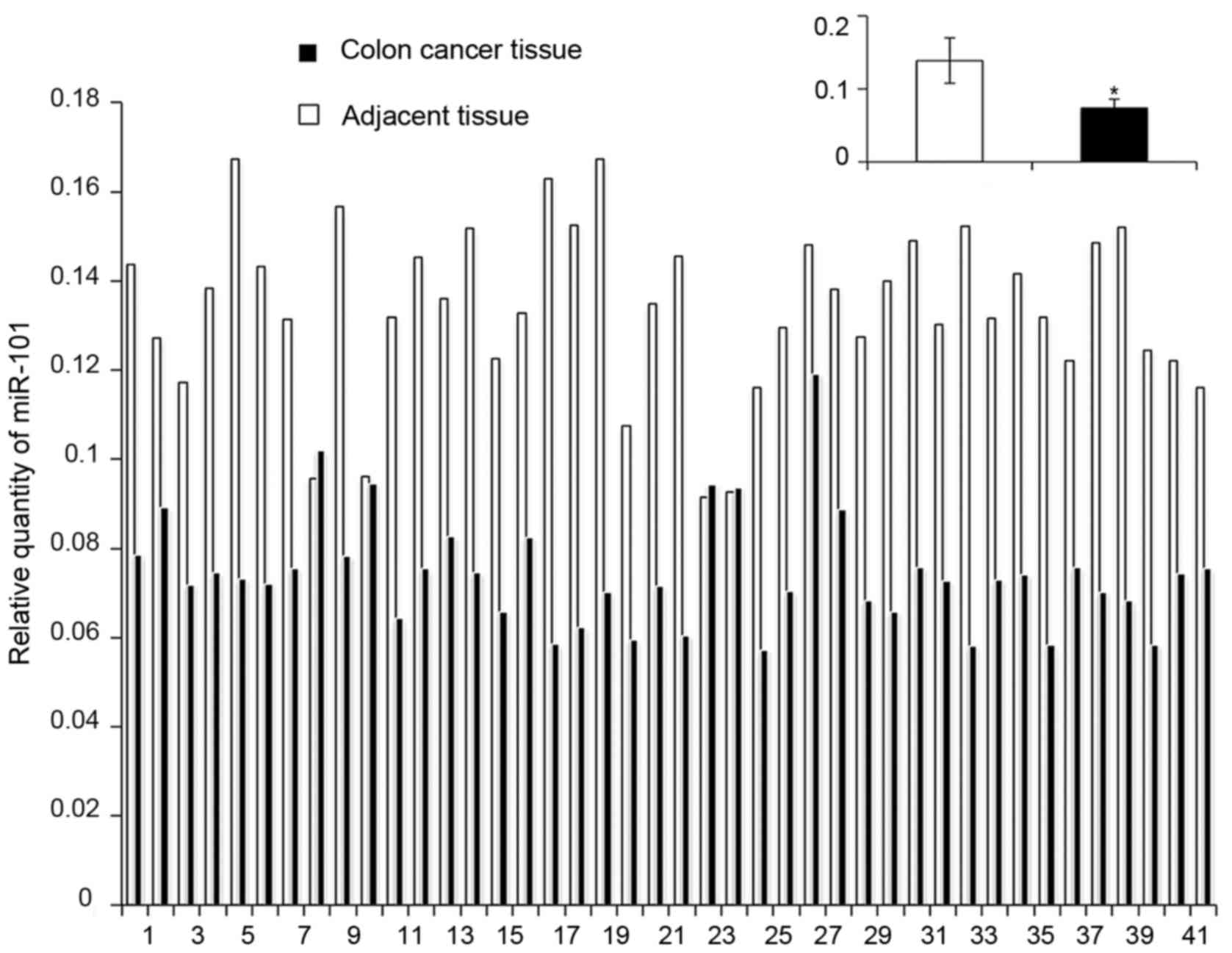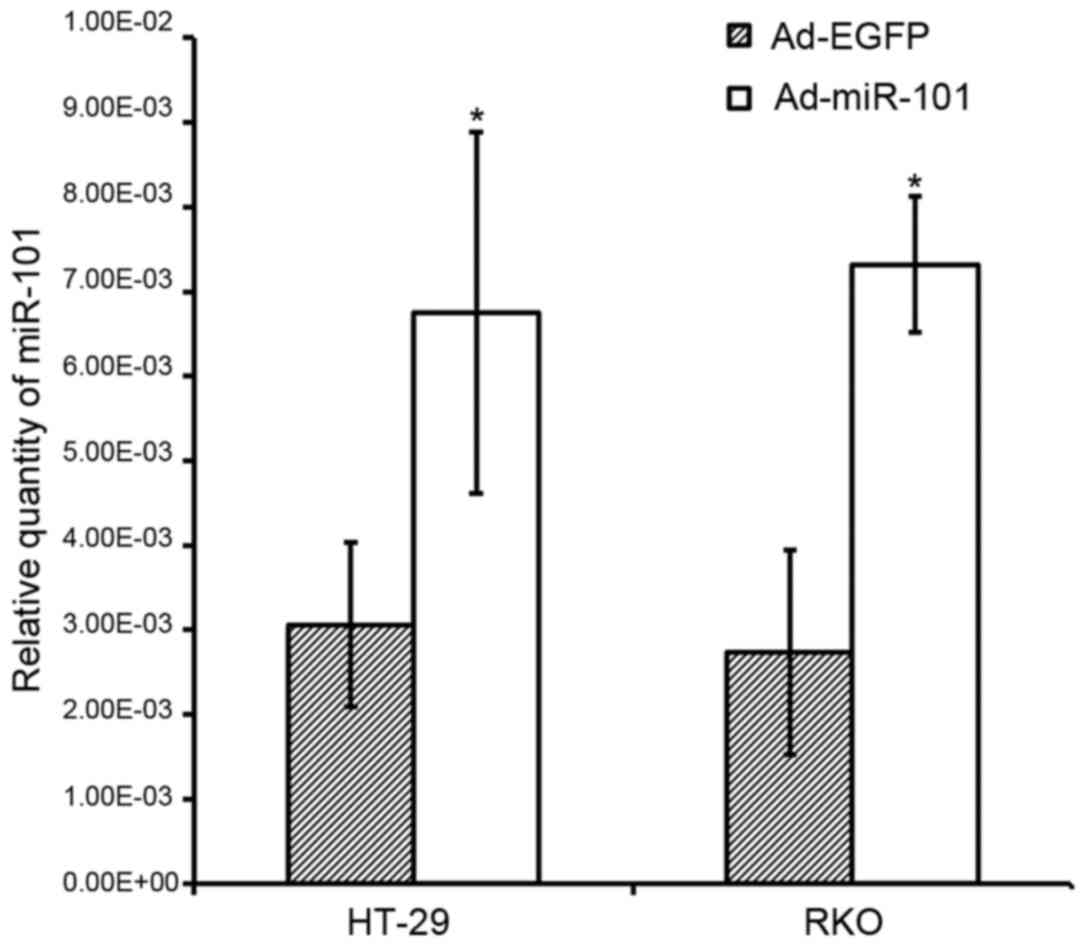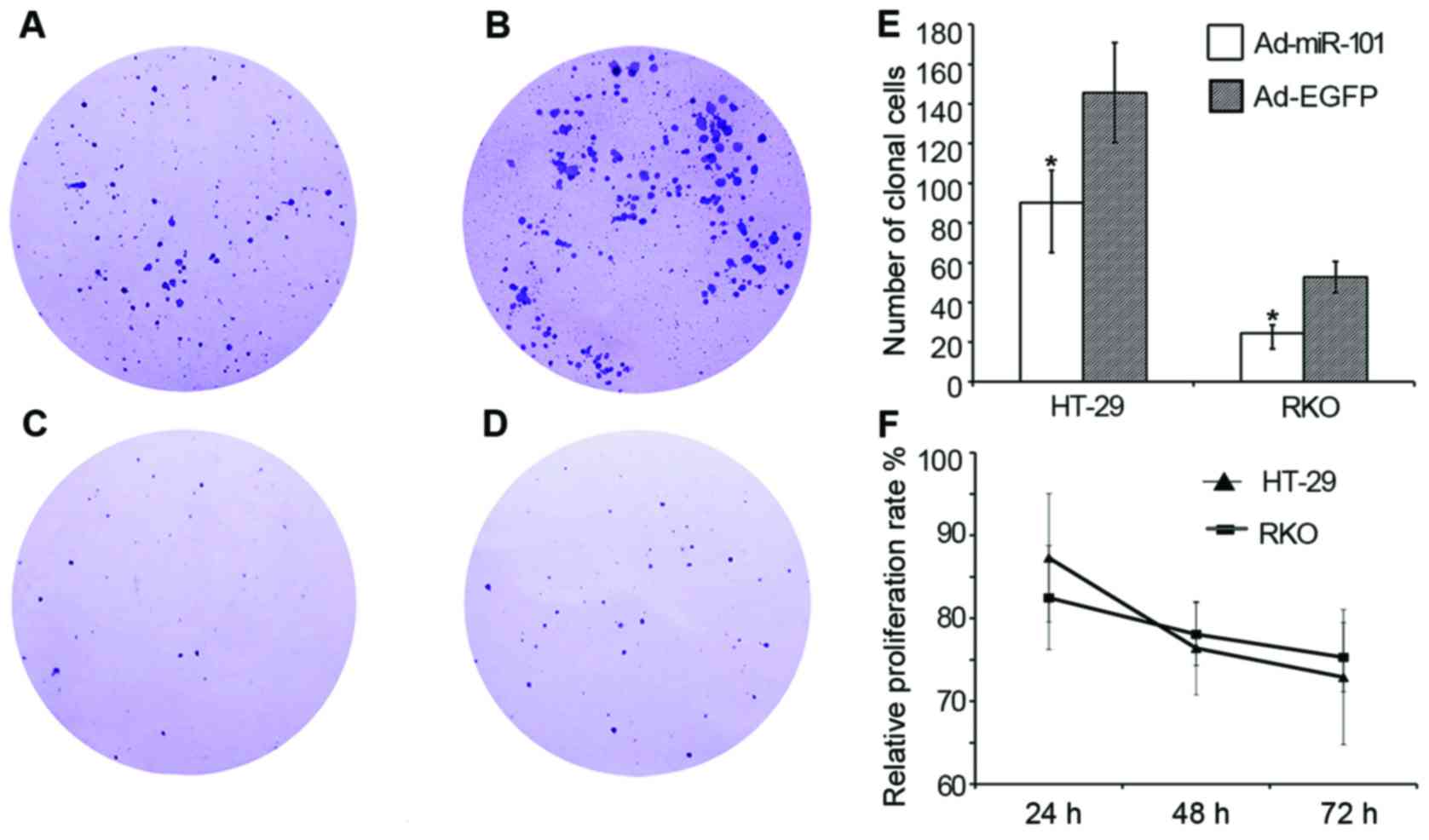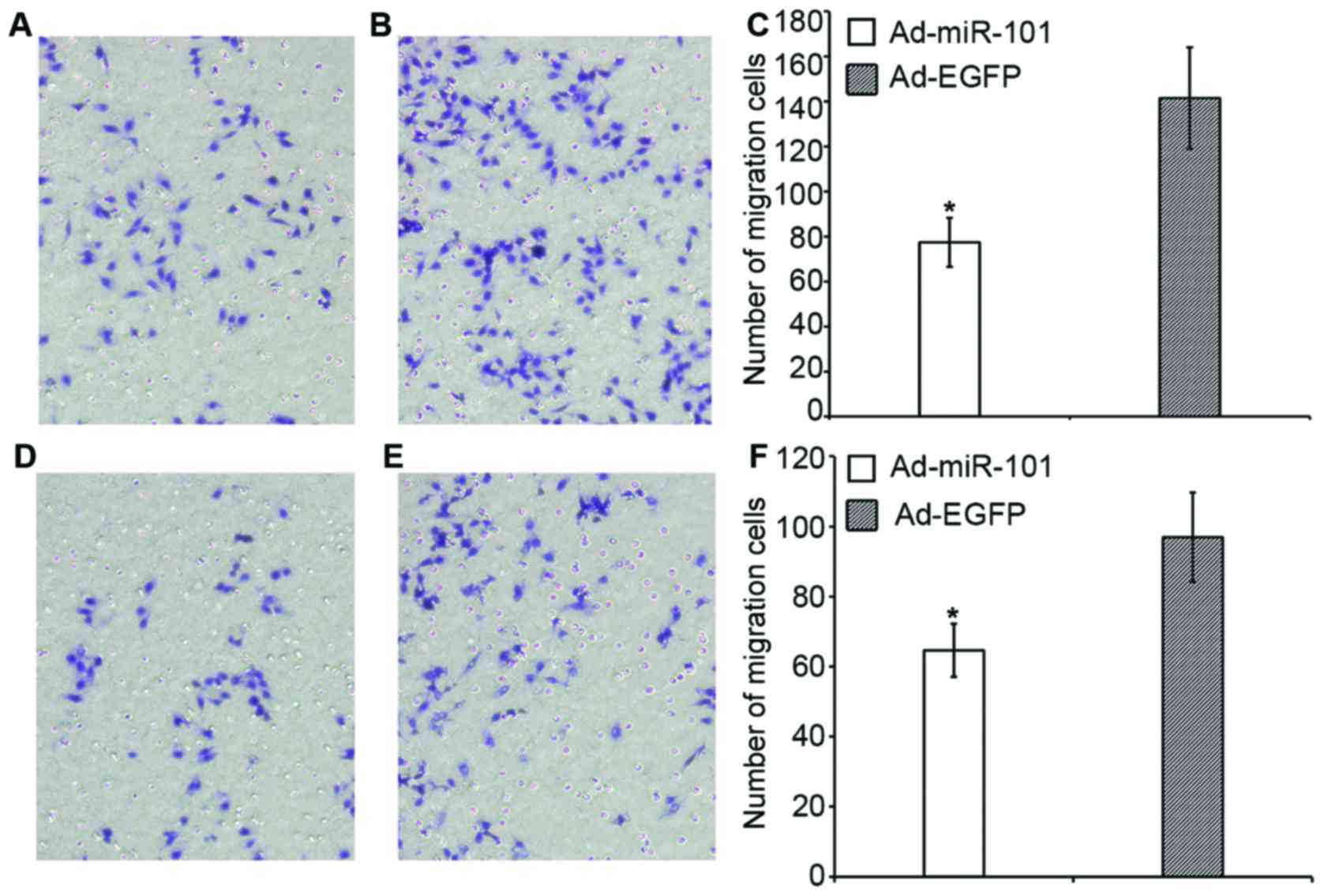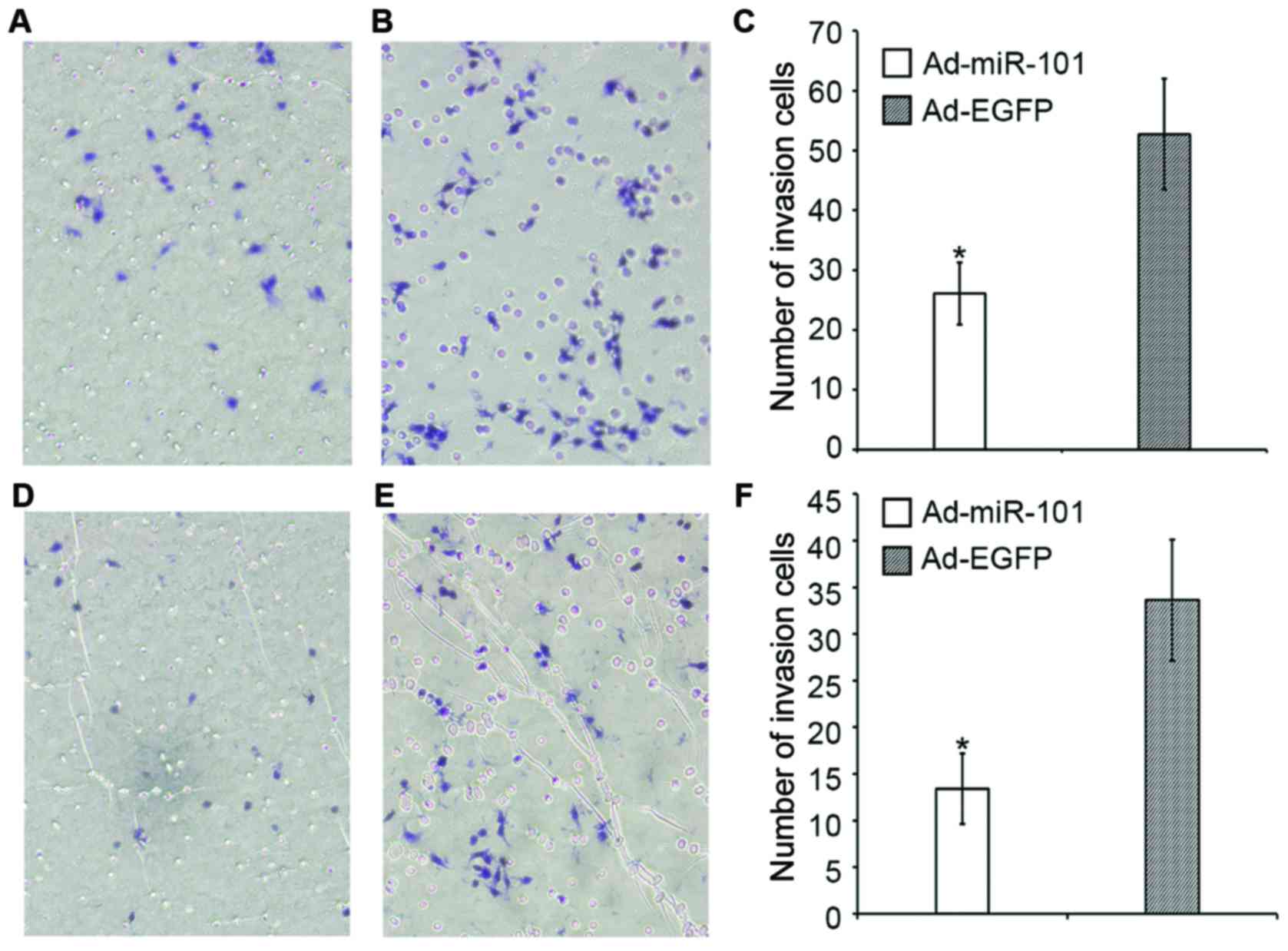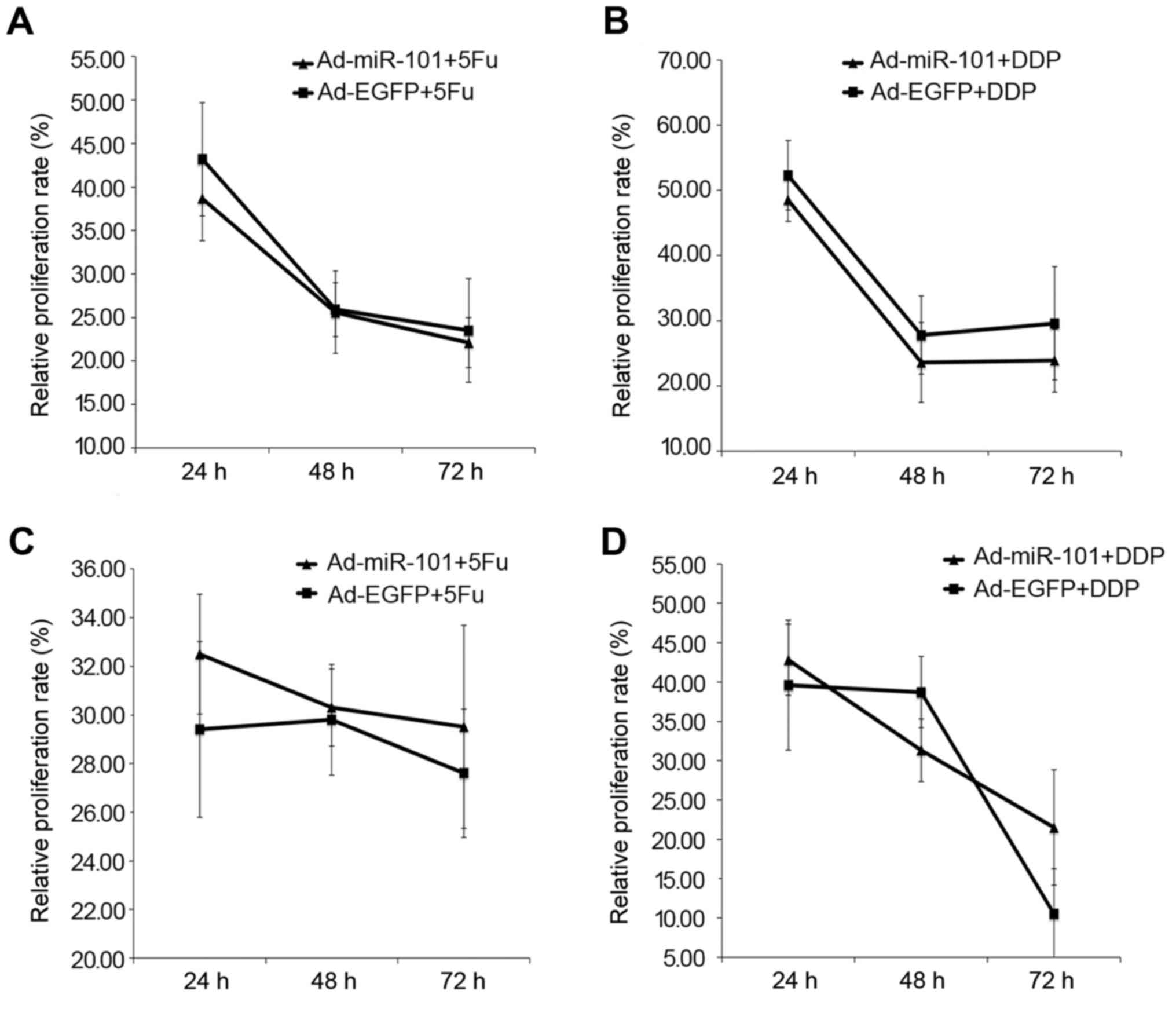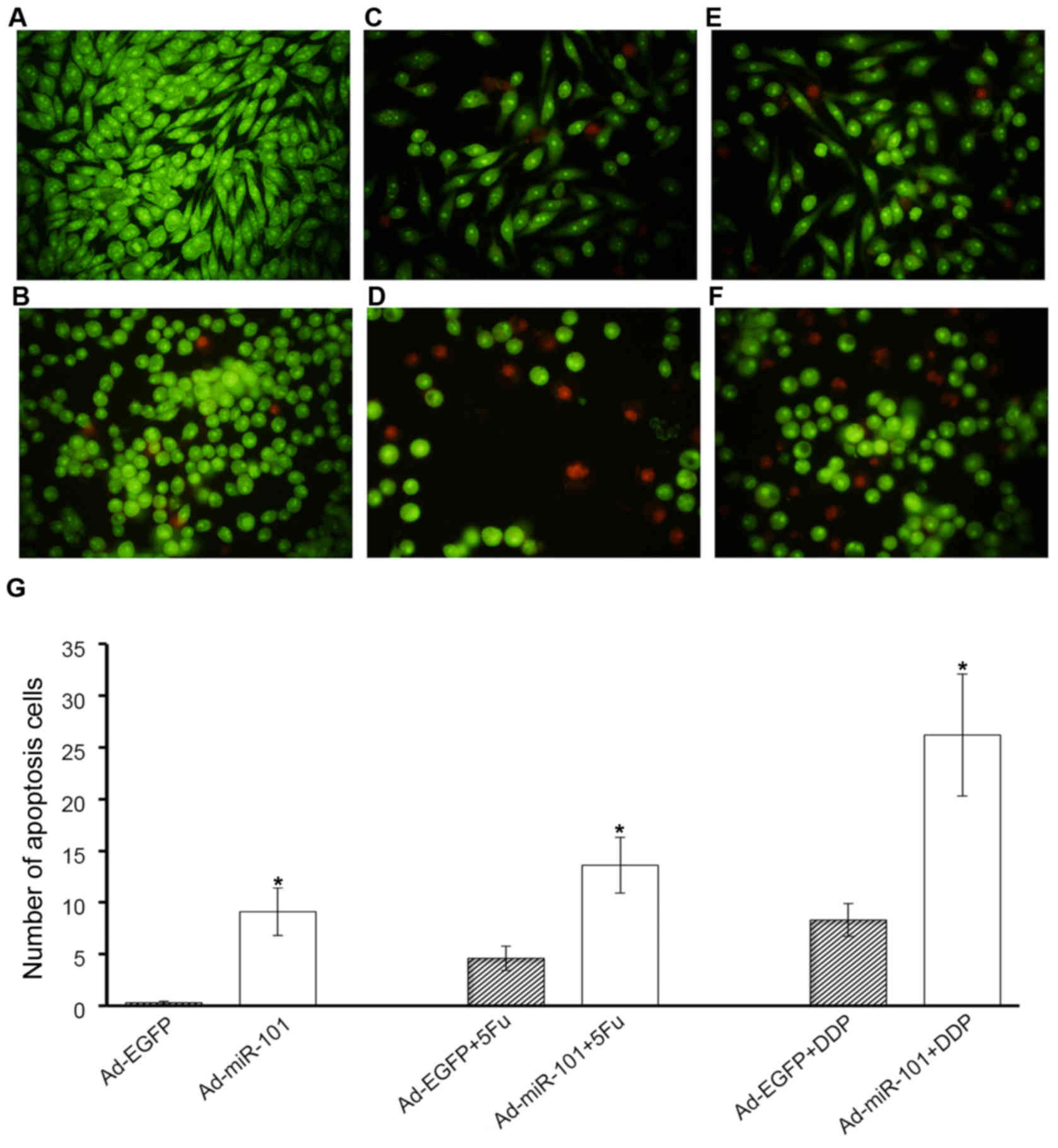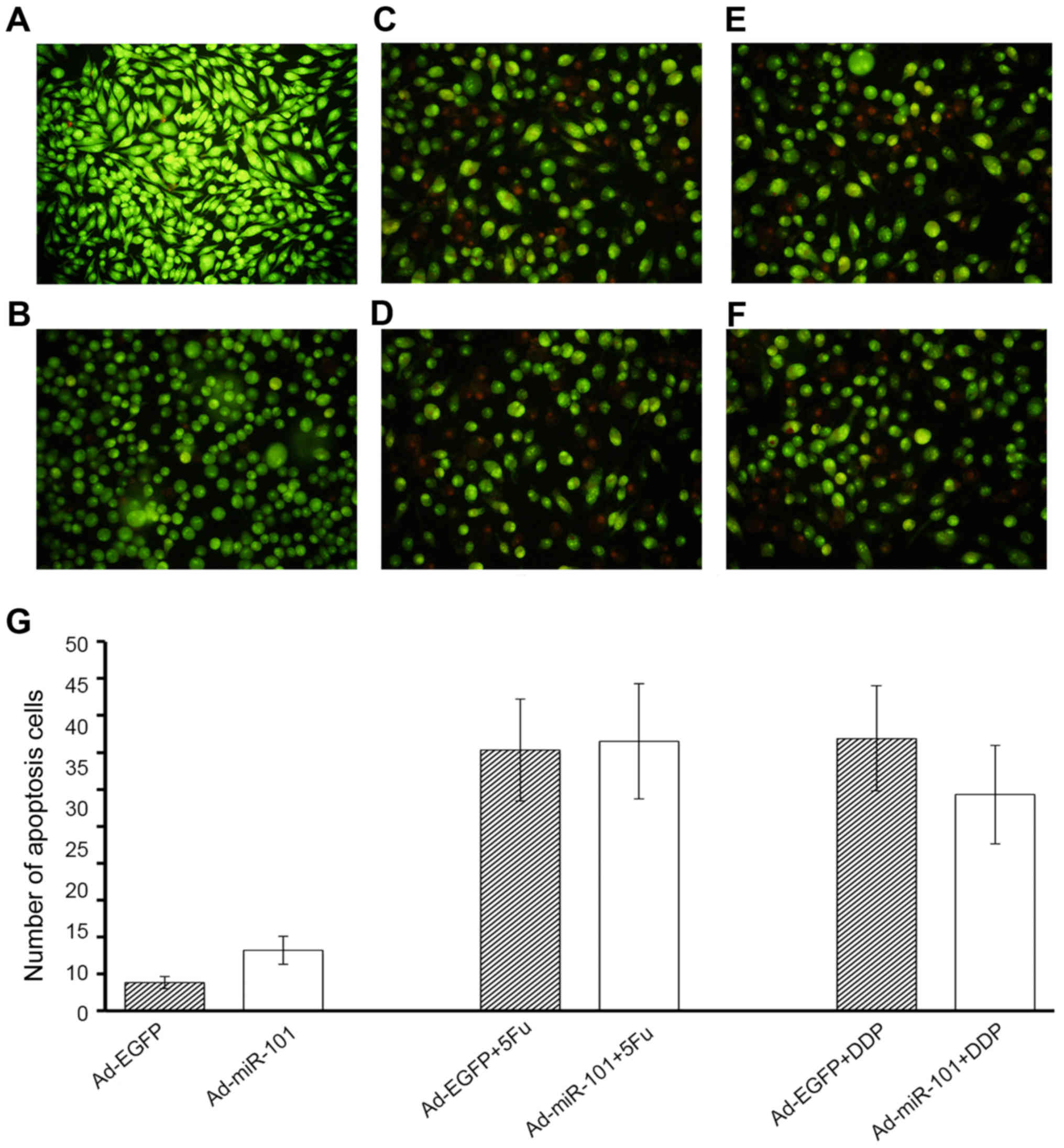Upregulation of miR-101 enhances the cytotoxic effect of anticancer drugs through inhibition of colon cancer cell proliferation
- Authors:
- Published online on: May 24, 2017 https://doi.org/10.3892/or.2017.5666
- Pages: 100-108
-
Copyright: © Chen et al. This is an open access article distributed under the terms of Creative Commons Attribution License.
Abstract
Introduction
Colon cancer is a commonly occurring malignant tumor in the world. It is considered as the fourth most commonly diagnosed cancer and the second leading cause of cancer-related death in China. Furthermore, due to environmental and lifestyle changes, the incidence of colon cancer has gradually increased (1,2). Nowadays, 5-fluorouracil (5-FU) and cisplatin (DDP) are widely used in treating colon cancer. However, drug resistance and rapid growth of tumors are the major obstructions in the treatment of colon cancer. Therefore, the combination of anticancer drugs and other regimens is often practiced to strengthen the efficacy of chemotherapy and suppress cancer proliferation. Previous research has proved that microRNAs (miRNAs) could restrain cancer cell growth and sensitize the pharmacological action of chemotherapy drugs (3–5).
miRNAs are a class of small noncoding RNA molecules that contain approximately 22 nucleotides. miRNAs are widely known to regulate gene expression at the post-transcriptional level and play an important role in diverse biological processes of cells, such as proliferation, differentiation, and apoptosis (6). Accumulated research indicates that aberrant miRNA expression is closely related to various types of human cancers (7). It has been reported that 50% of miRNAs are located in the chromosomal regions, which often increase or decrease in human cancer cells (8). Altered miRNA expression profiles are reported in many types of cancers, including liver, gastric, and prostate cancers (9–11). Moreover, recent studies revealed that miRNAs could function as tumor suppressors or oncogenes in human colon cancer (12,13).
Quantitative reverse transcription polymerase chain reaction (qRT-PCR) was used in this study to detect the expression of miR-101 in colon cancer tissues and adjacent normal tissues. Recombinant adenovirus Ad-miR-101 was used to upregulate the expression of miR-101 in HT-29 and RKO colon cancer cells, and the effects of miR-101 on cell proliferation, colony formation, migration, and invasion abilities were analyzed. Moreover, the effect of miR-101 on the drug sensitivity of colon cancer cells to 5-FU and DDP was explored. This investigation provided insight into the function of miR-101 in colon cancer and indicates the potential application of miR-101 in cancer therapy.
Materials and methods
Patients
Forty-two pairs of matched colon tumorous and adjacent non-tumorous mucosal tissues (>5 cm from the edge of the tumor) were collected from the patients with colon cancer at the Zhejiang Provincial People's Hospital between April 2015 and December 2015. The cohort comprised 20 patients aged <60 years and 22 patients aged ≥60 years. The patient age ranged from 43 to 87 years; 17 had left colon tumor and 25 had right colon cancer. Furthermore, 13 had adenocarcinoma and 29 had mucinous carcinoma. The number of patients classified by TNM stage were as follows: 36 were at TNM stages I–III and 6 were at TNM stage IV. Informed consent from all the patients, before surgery was obtained prior to the use of their tissues. The use of all specimens was approved by the ethics committee of Zhejiang Provincial People's Hospital. None of the patients received radiotherapy or chemotherapy prior to the operation. After surgical removal, the tissues were immediately frozen in liquid nitrogen and stored at −80°C until further use.
Cell culture
Human colon cell lines HT-29 and RKO were purchased from Shanghai Institute of Digestive Surgery (Shanghai, China) and cultured in Dulbecco's modified Eagle's medium (DMEM) containing 10% fetal bovine serum, 50 U/ml penicillin, and 50 µg/ml streptomycin at 37°C under an atmosphere of 5% CO2. Medium renewal was performed every 3–4 days, and subculturing was done when the cells reached 80–90% confluence.
Reagents
TRIzol reagent was purchased from Invitrogen (Carlsbad, CA, USA; 15596–018). One-Step Prime Script miRNA cDNA synthesis kit and SYBR Premix Ex Taq II quantitative PCR reagent box were purchased from Takara, Japan. Recombinant adenovirus Ad-miR-101 and Ad-EGFP were constructed by the key laboratory of gastroenterology of Zhejiang Province. 3-(4,5-Dimethylthiazol-2-yl)-2,5-diphenyltetrazolium bromide (MTT), acridine orange (AO), and ethidium bromide (EB) were obtained from Sigma (St. Louis, MO, USA; CA1140). Migration kit (Transwell chamber) assays were obtained from BD Biosciences (Franklin Lakes, NJ, USA; PIEP12R48); invasion kit (Boyden chamber) assays were purchased from Millipore Corp. (Billerica, MA, USA; QIA129-1KIT).
Detection of miR-101 in colorectal cancer tissues and adjacent tissues
Total RNA extraction and reverse transcriptionTotal RNA was extracted according to the RNA Extraction kit protocol. cDNA was synthesized by a reverse transcription reaction: 2X miRNA reaction buffer mix (10 µl), 0.1% phosphate-buffered saline (PBS) (2 µl), miRNA Prime Script RT enzyme mix (2 µl), total RNA (1 µl), and RNase-free dH2O (5 µl); reaction conditions: 37°C for 60 min and 85°C for 5 sec.
qRT-PCR assay for miR-101miR-101 positive specific primer sequence: 5′-TACAGTACTGTGATAACTGAA-3′, reference U6B specific forward primer sequence: 5′-ACGCAAATTCGTGAAGCGTT-3′; the reverse primer was the universal primer provided by the reverse transcription kit. PCR reaction system: SYBR Premix 10 µl, ROX 0.4 µl, reverse primer 0.5 µl, template 1 µl, and dH2O 7.6 µl; reaction conditions: 94°C for 4 min, 40 cycles of 94°C for 5 sec, 55°C for 20 sec, and 72°C for 20 sec; melting curve program: 95°C for 1 min, 55°C for 30 sec, and 95°C for 30 sec, 1 cycle. The relative expression of miR-101 was calculated by the 2−∆Ct method: ∆Ct = Ct(miR-101) - Ct(U6B).
Recombinant adenovirus infectionRecombinant adenovirus Ad-miR-101 was used to infect HT-29 and RKO cells at a multiplicity of infection of 100 to upregulate the expression level of miR-101. Recombinant adenovirus Ad-EGFP was used as the control. The infected cells were harvested and used for the following assays 24 h after infection. The miR-101 levels of infected cells were detected by qRT-PCR.
MTT assay and colony formation assay for cell proliferation
MTT assay for cell proliferationAd-mir-101- and Ad-EGFP-infected HT-29 and RKO cells were added to 96-well plates at a concentration of 2×103 cells/well in sextuple and placed at 37°C in a 5% CO2 incubator with saturated humidity. The MTT reagent (5 mg/ml, 20 µl) was added to each well and further incubated for 4 h after 24, 48, and 72 h. Dimethyl sulfoxide (150 µl) was added to quench the reaction, and the absorbance (A) was measured at 570 and 630 nm using a microplate reader. The relative cell proliferation rate was calculated by the following formula:
Relativeproliferationrate(%)=(A570nm–A630nm)studygroup(A570nm–A630nm)controlgroupx100% Colony formation assayA total of 200 cells from the experimental and control groups were cultured in a 6-well plate; the medium was replenished every 5 days. The colonies were fixed with methanol for 15 min and stained with Giemsa stain after 2 weeks.
In vitro migration and invasion assay
Migration assayA 24-well Transwell chamber kit was used for the assay. DMEM culture medium (200 µl, without any bovine serum) containing 4×104 cells from the experimental and control groups was added to the upper chamber, and 10% bovine serum was added to the lower chamber. The cells were removed from the chamber with a cotton swab 24 h post-culture. The cells adhering below the surface of a membrane were fixed in methanol and stained. Five randomly selected fields of view (x200) were observed under the microscope to count the cells and calculate the mean.
Invasion assayThe Matrigel invasion chamber kit was used for the assay. DMEM culture medium (300 µl) without any bovine serum was added to the upper chamber, and 5×105 cells from each group were suspended in it. The lower chamber consisted of DMEM with 10% bovine serum. The cells were fixed and stained after 48-h incubation; the cells in five randomly selected fields of view (x200) were counted under a microscope, and the average was calculated.
MTT assay and AO/EB staining analysis of the sensitivity to chemotherapeutics
MTT assay for sensitivity to chemotherapeuticsMTT assay was performed to analyze the synergism between miR-101 and 5-FU or DDP in cell proliferation. Ad-miR-101- and Ad-EGFP-infected HT-29 and RKO cells were seeded in 96-well plates at 2×103 cells per well overnight. Then, the cells were treated with PBS or 5-FU (5 µg/ml) or DDP (1 µg/ml). At the end of 24-, 48-, and 72-h incubation, the MTT assay was performed as described earlier. Ad-EGFP-infected cells in PBS served as the negative control.
Relativeproliferationrate(%)=(A570nm–A630nm)studygroup(A570nm–A630nm)negativecontrolgroupx100% AO/EB double staining for detecting sensitivity to chemotherapeuticsAO/EB staining was performed to analyze the synergism between miR-101 and 5-FU or DDP in cell apoptosis. Ad-miR-101- and Ad-EGFP-infected HT-29 and RKO cells were seeded in 24-well plates at 2×104 cells per well overnight. Then, PBS or 5-FU (5 µg/ml) or DDP (1 µg/ml) was added to respective wells. The culture medium in each well was replaced with 100 µl of PBS 24 h later. Then, the cells were stained with dual fluorescent staining solution (2 µl) containing 100 µg/ml AO and 100 µg/ml EB, and viewed under an epifluorescence microscope. Multiple photographs at ×400 magnification were taken for analyzing the results.
Statistic analysesSPSS18.0 statistical software was used for data analysis. Measurement data were expressed as mean ± standard deviation. Paired data were analyzed using paired-samples t-test, and ranked data using χ2 or Fisher's exact test. Statistical significance was set at P<0.05.
Results
Decreased expression of miR-101 in colon cancer tissues
The relative expression of miR-101 in colon cancer tissues was significantly lower than that in the adjacent tissues (7.40×10−2±1.22×10−2 vs. 1.31×10-1±3.11×10−2, P<0.05) (Fig. 1). Moreover, the expression of miR-101 was negatively correlated with the pathological type of colon cancer in patients (P<0.05), but it was not correlated with sex, age, tumor location, TNM staging, and differentiation (P>0.05) (Table I).
miR-101 expression is upregulated 24 h after infection
The results showed that the expression level of miR-101 of Ad-miR-101-infected HT-29 and RKO cells (6.75×10−2±2.14×10−3 and 7.32×10−3±8.01×10−4) was much higher than that of the Ad-EGFP-infected cells (3.06×10−3±9.70×10−4 and 2.73×10−3±1.21×10−3, P<0.05, Fig. 2).
In summary, the expression of miR-101 of HT-29 and RKO cell lines was significantly higher than that of the negative control group after Ad-miR-101 infection. These results suggested that Ad-miR-101 could effectively upregulate the expression of miR-101 in colorectal cancer cell lines.
Effect of miR-101 on the proliferation of HT-29 and RKO cells
MTT assay results (Fig. 3) showed that the relative proliferation rate of HT-29 cells in the experimental group was 87.3±7.74%, 76.4±5.63%, and 72.9±8.15% after 24-, 48-, and 72-h cultures, respectively (P<0.05), compared with the negative control group. The relative proliferation rate of RKO cells in the experimental group was 82.5±6.26%, 78.1±3.78%, and 75.3±4.17% (P<0.05). It indicated that the upregulation of miR-101 expression could inhibit the proliferation of colon cancer cell lines HT-29 and RKO.
Consequently, the cloning formation assay was used after 2 weeks to detect the cell proliferation ability. HT-29 and RKO cell lines with overexpressed miR-101 demonstrated the clone formation ability (90.3±16.4 and 24.5±4.2, respectively), and the clone formation ability of the negative control group was 145.7±25.2 and 52.8±7.9, respectively. The clone formation ability of the experimental group decreased significantly compared with the negative control group (P<0.05), as shown in Fig. 3. The results suggested that the upregulation of miR-101 had a significant inhibitory effect on the proliferation of colon cancer cell lines HT-29 and RKO.
Effect of miR-101 on the migration and invasion of colon cancer cells
The migration and invasion abilities of overexpressed miR-101 cells were significantly lower than those of the negative control group. Fig. 4 shows that in the migration assay, the number of HT-29 cells in the experimental and negative control groups was 77.4±10.9 and 141.5±22.7, respectively; the invasion capacity decreased approximately 45.3% (P<0.05). The number of RKO cells in the experimental and negative control groups was 64.6±7.6 and 96.9±12.8, respectively; the migration ability decreased approximately 33.3% (P<0.05).
Fig. 5 shows that in the invasion assay, the number of HT-29 cells in the experimental and negative control groups was 26.1±5.2 and 52.7±9.3, respectively; the invasion capacity decreased approximately 50.4% (P<0.05). The number of RKO cells in the experimental and negative control groups was 13.4±3.8 and 33.6±6.5, respectively; the invasion ability decreased approximately 60.1% (P<0.05).
miR-101 could enhance the sensitivity to chemotherapeutics
MTT assays showed that miR-101 increased the inhibitory effect of 5-FU and DDP on HT-29 cells. Fig. 6A shows that the relative proliferation rate of HT-29 cells in the experimental group was 38.7±6.53%, 25.6±3.11%, and 22.1±5.97%, respectively, 24, 48, and 72 h after FU treatment (P<0.05) compared with the negative control group; the relative proliferation rate of Ad-EGFP-infected HT-29 cells was 43.2±4.89%, 25.9±4.73%, and 23.5±2.87%, respectively (P<0.05). Therefore, the relative proliferation rate of Ad-miR-101-infected cells was less than that of Ad-EGFP-infected cells (P<0.05), implying that miR-101 could improve the chemotherapy of HT-29 cells by 5-FU.
Fig. 6B shows that the relative proliferation rate of Ad-miR-101-infected HT-29 cells was 48.5±5.32%, 23.6±5.99%, and 23.9±8.67%, respectively, 24, 48, and 72 h after DDP treatment (P<0.05) compared with the negative control group; the relative proliferation rate of HT-29 cells in the negative control group was 52.3±3.26%, 27.8±6.12%, and 29.6±4.84%, respectively (P<0.05). Therefore, the relative proliferation rate of Ad-miR-101-infected cells was less than that of Ad-EGFP-infected cells (P<0.05), implying that miR-101 enhanced the cytotoxic effect of DDP in HT-29 cells. However, the sensitivity to chemotherapy was not increased by the overexpression of miR-101 in RKO cells.
Fig. 6C shows that the relative proliferation rate of HT-29 cells in the experimental and negative control groups was 32.5±2.47%, 30.3±1.59%, and 29.5±4.18%, and 29.4±3.62%, 29.8±2.28%, and 27.6±2.64%, respectively, 24, 48, and 72 h after 5-FU treatment (P>0.05). The difference between the two groups was not statistically significant. It did not imply that miR-101 could improve the killing effect of 5-FU on RKO cells.
Fig. 6D shows that the 24-, 48-, and 72-h relative proliferation rate of RKO cells in the experimental group was 42.8±4.53%, 31.3±3.97%, and 21.5±7.33%, and the relative proliferation rate of RKO cells in the negative control group was 39.6±8.26%, 38.7±4.52%, and 10.5±5.74%, respectively, on DDP treatment. No significant difference was observed between the two groups (both P>0.05). It did not imply that miR-101 could improve the killing effect of cisplatin on RKO cells.
AO/EB staining indicated that miR-101 could sensitize HT-29 cells to apoptosis induced by 5-FU and DDP. In negative control groups, a small number of apoptotic HT-29 cells were stained (0.3±0.17). The overexpression of miR-101 could increase the apoptosis of HT-29 cells (9.1±2.3). Moreover, miR-101 could increase the number of apoptotic cells induced by 5-FU significantly (4.6±1.2 vs. 13.6±2.7). The number of apoptotic cells increased from 8.3±1.6 to 26.2±5.9, 24 h after low-dose DDP treatment. It indicated that miR-101 could improve the chemotherapeutic effect of 5-FU and DDP in HT-29 cells (Fig. 7).
Despite exhibiting antitumor properties in RKO cells, miR-101 failed to consolidate the inhibitory roles of 5-FU and DDP. It was observed that overexpression of miR-101 could increase the apoptosis of RKO cells (3.8±0.8 vs. 8.2±1.9). However, the differences in the number of apoptotic cells between the experimental and negative control groups were not statistically significant on treatment with 5-FU or DDP, as shown in Fig. 8 (35.3±6.9 vs. 36.5±7.8; 36.9±7.1 vs. 29.3±6.7). It did not imply that miR-101 and antitumor drugs had a synergistic effect in RKO cells.
Discussion
Dysregulation of miRNAs has frequently been observed in human cancers, yet the molecular mechanisms of the involvement of miRNAs in tumorigenesis and the behavior of cancer cells remain to be explored (6). Recently, many studies have indicated the participation of miRNAs in the occurrence and development of colon cancer as oncogene or tumor suppressor gene (7). Previous studies (14) have indicated that the expression of miR-200c decreases in colon cancer tissues and blood circulation in patients. Therefore, it may be used as a tumor marker in the diagnosis of colon cancer. Another study (15) found that miR-373 could stimulate abnormal mitosis and morphological changes in the cells (epithelial polarity deletion, restructuring of cells, and functional chaos), leading to the occurrence and development of cancer; miR-205 could promote the secretion of KLF4, MUC2, and TGFβ1, resulting in resistance to chemotherapy. When these two kinds of miRNAs were overexpressed, the tumor progression was rapid and the prognosis was poor. The above research suggested that the ectopic expression of miRNAs could be used in the diagnosis and treatment of various malignant tumors. We investigated the abnormal expression of miRNA in colorectal cancer and its role in tumorigenesis and development, which could provide a theoretical basis for the eradication of tumors. Therefore, in this study we analyzed not only the expression of miR-101 in colon cancer tissues and adjacent normal tissues, but also the relationship between the expression and the clinicopathological characteristics of colon cancer. Ad-miR-101 was used to upregulate the miR-101 level in HT-29 and RKO cells, and the biological role of miR-101 in cell proliferation, invasion, migration, and chemotherapeutic sensitivity was explored.
Recent studies have reported miR-101, whose whole sequence is TACAGTACTGTGATAACTGAA, as an important tumor suppressor. Its expression decreased or was missing in various human cancers, such as embryonal rhabdomyosarcoma (eRMS), endometrial cancer, and hepatocellular carcinoma (16–18). However, not many studies show the relationship between miR-101 and colon tumor. Vella et al (16) found that miR-101 could restrain the migratory potential of eRMS cells by repressing enhancer of zeste homolog 2 (EZH2). In aggressive endometrial cancer cells, re-expression of miR-101 not only inhibited cell proliferation, migration, and invasion but also induced cell apoptosis and enhanced chemosensitivity to paclitaxel. This is similar to our experimental results. Our experiments in vitro showed that miR-101 expression was decreased in colon cancer tissues and negatively correlated with the pathological type, but not with the patient's sex, age, tumor location, TNM stage, or degree of differentiation.
Another study in vivo found that the upregulated expression of miR-101 suppressed proliferation, migration, and invasion and induced apoptosis in HT-29 and RKO cell lines. These results indicate that miR-101 is potentially an anti-oncogene with negative regulation on the occurrence and development of colon cancer. The ectopic overexpression of miR-101 markedly repressed proliferation, invasion, colony formation, and cell cycle progression in human hepatocellular carcinoma cells and suppressed tumorigenicity in vivo. Furthermore, miR-101 inhibited autophagy and synergized with either doxorubicin or fluorouracil to induce apoptosis in tumor cells. Consistent with previous studies, our present study revealed that miR-101 could boost the apoptosis of HT-29 cells induced by 5-FU and DDP. This means miR-101 played an additional role in colon cancer chemotherapy. To summarize, this study confirmed the tumor suppressive role of miR-101 in colon cancer and provided evidence for the potential uses of miR-101 in miRNA-based cancer therapy.
Regardless of the latest advances in research, drug resistance remains a heavy burden in colon cancer therapy and patient prognosis. One way to solve this problem is to find novel therapeutic compounds for cancer treatment. The potential processes of chemotherapy regulated by miRNAs remain to be evaluated, and their merits of prognosis have not been well identified. However, the role of miRNAs in oncotherapy has been a hot topic recently. For instance, the overexpression of miR-21 increased the resistance of prostate cancer cells to docetaxel, while the decreased expression of miR-34a, miR-143, miR-148a, and miR-200 family was involved in resistance to anticancer drugs by the inhibition of apoptosis and the activation of signaling pathways (19). Vanas et al (20) found that ectopic expression of miR-21 resulted in weakened resistance toward cisplatin while the reduction in miRNA-21 activity showed the opposite effect in osteosarcoma-derived cell lines. Zhao et al (21) suggested that miR-770-5p expression decreased in platinum-resistant patients and could predict the response to cisplatin treatment. Endogenous miR-770-5p might function as an antioncogene by negatively regulating ERCC2 and restored chemosensitivity to cisplatin due to the inhibition of DNA repair.
Hu et al (22) found that the ectopic expression of miR-205 led to an increase in apoptosis and resensitization of both drug-resistant cell lines to doxorubicin and Taxol in breast cancer. They further showed that miR-205 levels were negatively correlated with the expression of VEGFA and FGF2 mRNA in patients with breast cancer. Besides, these phenomena were also observed in mouse tumor xenografts. The present study revealed that miR-101 increased the sensitivity of HT-29 colon cancer cells to chemotherapy through strengthening the inhabitation of cell proliferation and accelerating induced apoptosis. However, no statistically significant interactions between miR-101 and anticancer drugs were found in RKO cells. As we known from ATCC, the HT-29 line is originated from tumor epithelium, which could form well differentiated adenocarcinoma in nude mice. While RKO containing wild-type p53 is a poorly differentiated colon carcinoma cell line. The different characteristics of the two cell lines is the cause of their differential expression of miR-101. The infection efficiency of HT-29 and RKO cell lines was also different. These distinctions might attribute to the different experimental results. The variations of the research data might also be related to the differences in cell biological behavior, drug influx and efflux, metabolism of the drug, drug action mechanisms, epithelial-to-mesenchymal transition, DNA damage response, and other factors, which needs further validation. The present results provided evidence that miR-101 might be a potent therapeutic agent in the treatment of colorectal cancer.
In summary, this study provides new insights into the role of miR-101 in human colon cancer. It showed that the expression of miR-101 decreased in colon cancer tissues compared with adjacent nontumor tissues. It was negatively correlated with the pathological type, but not with the patient's sex, age, tumor location, TNM stage, and degree of differentiation. The upregulated expression of miR-101 suppressed cell proliferation and inhibited cell migration and invasion in HT-29 and RKO colon cancer cell lines. This study confirmed the tumor suppressive role of miR-101 in colon cancer and provided evidence for the potential uses of miR-101 in miRNA-based cancer therapy.
Acknowledgements
This work was supported by Zhejiang Province medical and health research project (2015114978).
References
|
Torre LA, Bray F, Siegel RL, Ferlay J, Lortet-Tieulent J and Jemal A: Global cancer statistics, 2012. CA Cancer J Clin. 65:87–108. 2015. View Article : Google Scholar : PubMed/NCBI | |
|
Sjo OH, Berg M, Merok MA, Kolberg M, Svindland A, Lothe RA and Nesbakken A: Peritoneal carcinomatosis of colon cancer origin: Highest incidence in women and in patients with right-sided tumors. J Surg Oncol. 104:792–797. 2011. View Article : Google Scholar : PubMed/NCBI | |
|
Mori F, Ferraiuolo M, Santoro R, Sacconi A, Goeman F, Pallocca M, Pulito C, Korita E, Fanciulli M, Muti P, et al: Multitargeting activity of miR-24 inhibits long-term melatonin anticancer effects. Oncotarget. 7:20532–20548. 2016.PubMed/NCBI | |
|
Patel Y, Shah N, Lee JS, Markoutsa E, Jie C, Liu S, Botbyl R, Reisman D, Xu P and Chen H: A novel double-negative feedback loop between miR-489 and the HER2-SHP2-MAPK signaling axis regulates breast cancer cell proliferation and tumor growth. Oncotarget. 7:18295–18308. 2016.PubMed/NCBI | |
|
Konishi H, Fujiya M, Ueno N, Moriichi K, Sasajima J, Ikuta K, Tanabe H, Tanaka H and Kohgo Y: microRNA-26a and −584 inhibit the colorectal cancer progression through inhibition of the binding of hnRNP A1-CDK6 mRNA. Biochem Biophys Res Commun. 467:847–852. 2015. View Article : Google Scholar : PubMed/NCBI | |
|
Bartel DP: MicroRNAs: Genomics, biogenesis, mechanism, and function. Cell. 116:281–297. 2004. View Article : Google Scholar : PubMed/NCBI | |
|
Farazi TA, Spitzer JI, Morozov P and Tuschl T: miRNAs in human cancer. J Pathol. 223:102–115. 2011. View Article : Google Scholar : PubMed/NCBI | |
|
Calin GA, Sevignani C, Dumitru CD, Hyslop T, Noch E, Yendamuri S, Shimizu M, Rattan S, Bullrich F, Negrini M, et al: Human microRNA genes are frequently located at fragile sites and genomic regions involved in cancers. Proc Natl Acad Sci USA. 101:2999–3004. 2004. View Article : Google Scholar : PubMed/NCBI | |
|
Chauhan R and Lahiri N: Tissue- and serum-associated biomarkers of hepatocellular carcinoma. Biomark Cancer. 8 Suppl 1:37–55. 2016. View Article : Google Scholar : PubMed/NCBI | |
|
Suárez-Arriaga MC, Ribas-Aparicio RM and Ruiz-Tachiquín ME: MicroRNAs in hereditary diffuse gastric cancer. Biomed Rep. 5:151–154. 2016.PubMed/NCBI | |
|
Mohamad M, Wahab NA, Yunus R, Murad NA, Zainuddin ZM, Sundaram M and Mokhtar NM: Roles of microRNA21 and microRNA29a in regulating cell adhesion related genes in bone metastasis secondary to prostate cancer. Asian Pac J Cancer Prev. 17:3437–3445. 2016.PubMed/NCBI | |
|
Lu J, Getz G, Miska EA, Alvarez-Saavedra E, Lamb J, Peck D, Sweet-Cordero A, Ebert BL, Mak RH, Ferrando AA, et al: MicroRNA expression profiles classify human cancers. Nature. 435:834–838. 2005. View Article : Google Scholar : PubMed/NCBI | |
|
Mukohyama J, Shimono Y, Yamashita K, Sumi Y, Mukohara T, Minami H and Kakeji Y: Effect of xenotransplantation site on microRNA expression of human colon cancer stem cells. Anticancer Res. 36:3679–3686. 2016.PubMed/NCBI | |
|
Kumar S, Nag A and Mandal CC: A comprehensive review on miR-200c, a promising cancer biomarker with therapeutic potential. Curr Drug Targets. 16:1381–1403. 2015. View Article : Google Scholar : PubMed/NCBI | |
|
Eyking A, Reis H, Frank M, Gerken G, Schmid KW and Cario E: MiR-205 and miR-373 are associated with aggressive human mucinous colorectal cancer. PLoS One. 11:e01568712016. View Article : Google Scholar : PubMed/NCBI | |
|
Vella S, Pomella S, Leoncini PP, Colletti M, Conti B, Marquez VE, Strillacci A, Roma J, Gallego S, Milano GM, et al: MicroRNA-101 is repressed by EZH2 and its restoration inhibits tumorigenic features in embryonal rhabdomyosarcoma. Clin Epigenetics. 7:822015. View Article : Google Scholar : PubMed/NCBI | |
|
Konno Y, Dong P, Xiong Y, Suzuki F, Lu J, Cai M, Watari H, Mitamura T, Hosaka M, Hanley SJ, et al: MicroRNA-101 targets EZH2, MCL-1 and FOS to suppress proliferation, invasion and stem cell-like phenotype of aggressive endometrial cancer cells. Oncotarget. 5:6049–6062. 2014. View Article : Google Scholar : PubMed/NCBI | |
|
Xu L, Beckebaum S, Iacob S, Wu G, Kaiser GM, Radtke A, Liu C, Kabar I, Schmidt HH, Zhang X, et al: MicroRNA-101 inhibits human hepatocellular carcinoma progression through EZH2 downregulation and increased cytostatic drug sensitivity. J Hepatol. 60:590–598. 2014. View Article : Google Scholar : PubMed/NCBI | |
|
Kopczyńska E: Role of microRNAs in the resistance of prostate cancer to docetaxel and paclitaxel. Contemp Oncol (Pozn). 19:423–427. 2015.PubMed/NCBI | |
|
Vanas V, Haigl B, Stockhammer V and Sutterlüty-Fall H: MicroRNA-21 increases proliferation and cisplatin sensitivity of osteosarcoma-derived cells. PLoS One. 11:e01610232016. View Article : Google Scholar : PubMed/NCBI | |
|
Zhao H, Yu X, Ding Y, Zhao J, Wang G, Wu X, Jiang J, Peng C, Guo GZ and Cui S: MiR-770-5p inhibits cisplatin chemoresistance in human ovarian cancer by targeting ERCC2. Oncotarget. 7:53254–53268. 2016.PubMed/NCBI | |
|
Hu Y, Qiu Y, Yagüe E, Ji W, Liu J and Zhang J: miRNA-205 targets VEGFA and FGF2 and regulates resistance to chemotherapeutics in breast cancer. Cell Death Dis. 7:e22912016. View Article : Google Scholar : PubMed/NCBI |



